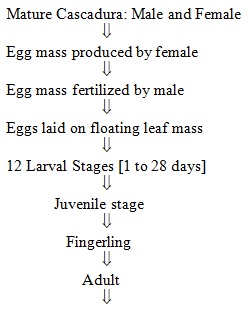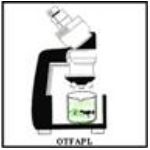Topics Covered in this Section
19.2.2 Factors Affecting Cascadura Production
19.2.3 An approach at developing an Intensive Animal Production System for the Cascadura
[I] The Objectives of the Production System or Model
III] The Physiological States for the Production Flow
[IV] Performance Coefficients or Growth Parameters
[VI] Animal Specific Needs as influenced by the Factors affecting animal Production Needs
[VII] Animal Behavior and Sociology
[VIII] Design of the Physical Environment Required
[IX] Management Routines Required
[XI] Output Expectations of the Model/Production Process Flow
AGLS 6502 Lecture 19.2 - The Cascadura (Hoplosternum littorale)
The learning objectives of this unit are as follows:
1. to be able to describe the production factors affecting the cascadura;
2. to understand the animal production coefficients and parameters for the cascadura and to see how this would relate to production of this species in captivity;
3. to become familiar with an approach to the intensification of cascadura production.
19.2.2 Factors Affecting Cascadura Production
Please refer to Ramnarine (1989) for details, but remember the following are the main factors affecting cascadura production-
- Water Quality,
- Adequate Supplementary Nutrition [30-35% CP of which about half must be of fish origin]
- Predation, and
- Stocking Density.
19.2.3 An approach at developing an Intensive Animal Production System for the Cascadura
Considerations for Species Production Modeling: The Species: Hoplosternum littorale [Cascadura]
- A Neotropical armored catfish, Bimodial Respiration
[I] The Objectives of the Production System or Model
(1) To develop and manage an intensive cascadura breeding colony.
(2) To grow out the cascadura to market weigh for sale as fresh water fish.
The time required to complete the life cycle is about 6 months.

[III] The Physiological States for the Production Flow
- Mature Cascadura: Male and Female
- Fertilized Egg Mass [ this could have up to 10,000 eggs]
- 12 Larval Stages[1 to 28 days]
- Juvenile stage [ 29 to 60 days ]
- Fingerling [ > 60 days or when lengths are > 5cm]
- Growing
[IV] Performance Coefficients or Growth Parameters
Live Wt at 6 months - 100g
[V] Reproductive Parameters
Male: Female Ratio in Brood Pond - 1:3
NB: The main rib of the Pectoral Fin of the Female Cascadura ends in a point while the main rib of the Pectoral Fin of the Male Cascadura ends in a hook.
[VI] Animal Specific Needs as influenced by the Factors Affecting Animal Production Needs
a. Housing
- Controlled Water Environment
- Hatchery System
- Juvenile System
- Grow out and Breeding Ponds
All require:
- Water Management System
- Drainage and Pumping of Filling or Water Exchange System
- Water Aeration System [ Aeration Pumps 0.5 TO 2 horse power ]
b. Nutrition and Feeding
- The provision of a reliable supply of fish feed daily to the pond;
28 to 30% CP for growing out animals.
c. Health and Disease Control
This is critical during the hatching and larval stages.
d. Reproductive Management
- To stimulate the laying of eggs in the Breeding Ponds the water levels have to be rapidly changed and green material around the perimeter of the pond is required for the animal to lay the egg mass.
- The egg mass appears as a foamy spongy like mass from about 3 to 8 inches in diameter.
- This mass has to be carefully removed and transferred to the hatchery and must be kept supplied with oxygen ( by bubbling air underneath the mass ] at all times.
[See Ramnarine (1994a) and (1989) for further details]
[VII] Animal Behavior and Sociology
[VIII] Design of the Physical Environment
The physical environment requires the following:
- Breeding / Brood Pond
- Hatchery Tanks
- Juvenile Tanks
- Grow out Ponds
- Sorting / Holding Ponds
- Aeration System
- Drainage and Water Control System
- Water Supply System
[IX] Management Routines Required
- Daily
- feeding
- aeration
- Weekly
- sorting animals
- Monthly
- Seasonally
- pond maintenance
- Annually
[X] Variable Inputs Required
-Feed
-Labour
[XI] Output Expectations of the Model/Production Process Flow
- De Souza, G. and Gabbadon, P. (1989): Fry production of the Cascadura, Hoplosternum littorale (Hancock 1928), Institute of Marine Affairs, Trinidad. 11pp
- Ramnarine, I. (1989): Cascadura farming, a manual for the culture of Hoplosternum littorale . Occasional Paper #7, Department of Zoology, The University of the West Indies, St Augustine, Trinidad. 34pp.
- Ramnarine, I. W. (1994a): Laval culture, development and growth of the cascadu, Hoplosternum littorale (Hancock 1828; Callichthyidae). Aquaculture 126: 291-298
- Ramnarine, I. W. (1994b): A field trial of the semi-intensive culture of the cascadu, Hoplosternum littorale ( Hancock 1828). Tropical Agriculture (Trinidad) 71: 135-138
- Singh, T. B. (1978): The biology of the cascadu, Hoplosternum littorale ( Hancock 1828) with reference to its reproductive biology and population dynamics. Ph.D. Thesis. The University of the West Indies, 298 pp.
Helpful Links, Photos, Videos and Multimedia
